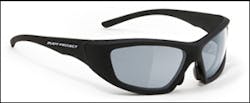Shown with this article are two photos of Rudy Project sunglasses. They are representative of their design flavor but not actual models tested.
The first time I saw a booth at a show for the Rudy Project I had no clue what it was. I thought it was a special event / fundraiser to benefit some kid named Rudy or to provide funding for research into whatever he suffered from. After a little paying attention I realized that the Rudy Project makes eyewear. More recently (a few months back) I had the chance to talk to the president of the company and learned that the company has been manufacturing eyewear for sportsman for some time, but now they’re pushing into the law enforcement market. Of course, I requested and received a few pair to test. Let me share what I learned.
First, I'd be remiss if I didn't mention that Rudy Project sunglasses were worn by 18 medalists at the Winter Olympics in Vancouver. You see, that's where the Rudy Project got its start: on athletes. Bicyclists, skiers, etc - they appreciated the stylish designs The Rudy Project produced. But "stylish" and "protective" are two different things. There's a reason I don't let my wife wear her normal sunglasses at the range - they provide no ballistic protection. That said, the rep from The Rudy Project issued me a challenge when I spoke to him several months back: he offered me a fairly substantial reward if I could break a lens in the sunglasses.
Now, how hard can that be, right? I mean, you mount the glasses on a target, shoot it with a .223 or .308 and it's going to shatter, right? Not the test lenses that I received, but I have to note that the test lenses are not the same thickness / shape / size as those in the sunglasses. The test lenses I received came in a cool test kit that included a rubber mallet and a pounding board plus two test lenses. Well, most of you readers know me: I ignored the rubber mallet and got out my three pound sledge hammer. I put the lenses on my concrete patio and took a few swings. Although the lenses did bounce and were marred some, they didn't crack or break. Hmm...
I decided to be a bit more abusive. Out came the chisel. Using that I managed to scratch and ding the lenses but I still didn't break them. I was getting frustrated. How hard could it be? Unfortunately, I don't have a rifle range in my back yard or I would have shot them with rifle rounds then and there.
I decided to a bit of research before making further attempts at destruction. I read more techno-babble than I could really understand on various websites and came to find out that the lenses Rudy Project uses are made of something called NXT - a polycarbonate material called ImpactX by Rudy Project. It is, and I quote, stronger than any other lens material, guaranteed not to break or crack, even in complex rimless frame.
16% lighter than CR-39 and 10% lighter than Polycarbonate.
has lower refractive index, internal stress and chromatic dispersion than polycarbonate, resulting in sharper images, higher definition, reduces "rainbowing", and more visual comfort.
Based on my abuse of the test lenses on my patio I felt that the material is indeed strong. Based on the research I did I felt that I was safe in being even more abusive. So, I put them in my driveway and drove over them a few times with my Jeep. No luck. Scratches but no breakage. I have now set them aside for a range trip to see how well they'll hold up.
As to the subjective information: I wore a pair of their Genetyk Hunting / Shooting glasses for a few days. I prefer the reflective lenses but the glasses also came with rose / red lenses and clear lenses. Yep, in case I forgot to mention it, they're interchangeable. Changing them isn't difficult and takes only a minute once you know what you're doing. The glasses provide good coverage from below the eye orbit to above the eyebrow (or at least the top of my bushy ones) and wrapped around right to the corner of my eyes. If I had my preference the lenses would extend a tad farther on each side to provide more protection but I suppose that can be accomplished by wearing a different style / model.
The glasses were comfortable enough and provided decent protection from the glare of the sun as I experienced it while wearing them. The lenses are photochromic meaning that they lighten and darken depending on the lighting conditions. While some photochromic lenses take several minutes to change, the Rudy Project lenses that I tested made the change in about 30 seconds. The published material I found said that the lenses accomplished the change within a few seconds - and maybe they did. Maybe my eyes took longer to adapt. If I had to guess I'd say the change took no less than ten seconds and I didn't feel it had been completely accomplished for 20-30 seconds. Again, this is a subjective perception. Perhaps with lab equipment a test can be performed that shows different.
Priced at approximately $200 per pair, the sunglassea are obviously stylish and that's not an unreasonable price when you look around at other "brand name" sunglasses. With a history of use amongst noted atheletes and olympic competitors, the Rudy Project glasses have become well accepted. It will be interesting to see what else they produce in the future. I will keep you updated on anything new I test or learn.
Stay Safe.
About the Author
Lt. Frank Borelli (ret), Editorial Director
Editorial Director
Lt. Frank Borelli is the Editorial Director for the Officer Media Group. Frank brings 20+ years of writing and editing experience in addition to 40 years of law enforcement operations, administration and training experience to the team.
Frank has had numerous books published which are available on Amazon.com, BarnesAndNoble.com, and other major retail outlets.
If you have any comments or questions, you can contact him via email at [email protected].

